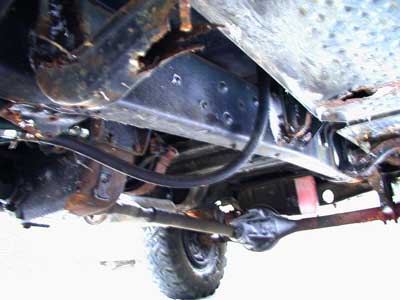|
|

|
'65 Dodge WM300 Power Wagon Drive Train from Beneath
|
| |
|
That's the underside of the pretty blue transmission, there. Just ahead of that is
the flywheel cover, then the voluminous oil pan. It has occasionally been necessary
to remove the flywheel cover, loosen the pressure plate bolts, then pry the damned
clutch disk off the flywheel so the truck doesn't immediately begin moving when started
in gear. It doesn't usually sit that long but there have been a couple of times...
|
I've also got to tell you about the muffler falling off. I've got a nice big can built
for the standard W300. Just the right sound to it. One day I'm cruising along and I am
suddenly engulfed in an overwhelming roar. I mean, this instantly set my ears ringing.
I don't know if flat heads are characteristically incredibly loud without an exhaust
system or if it's just the manifold arrangement on the 251, but I am here to tell you
that your priorities undergo an immediate reordering. You ever see someone trying to
plug his ears with his shoulders while wrestling a large uncooperative truck off the
road?
Fortunately, I had enough experience not to run back and grab the
damn muffler, fresh out of the oven. A little gem of related wisdom; never pick up a
dry muffler on a rainy day. Anyhow, I waited for the thing to cool off, then fought it
back on the head pipe. It got me home where, despite my policy of tightening the clamps
as lightly as possible to facilitate removal, I cramped on the nuts just a tad because
I'm not going to voluntarily listen to that mutha unmuzzled again.
|
 '65 Dodge Power Wagon drive train, looking forward.
'65 Dodge Power Wagon drive train, looking forward.
|
|
This isn't a very good picture, and it serves to reveal the sorry state of my running
board mounts. I've got a new set partially under construction. No doubt summer will
supply the ambition to carry that project to fruition. Actually, though, they've been
like that for a number of years, so there's probably no certainty that anything will
change right away. An Ancra tie down is just the right length to hook over the front
lip of the fender, inboard of the headlight, then run back and hook beneath the running
board.
The astute and savvy WM300 Dodge Power Wagon observer will note the absence of the vacuum
brake booster. I had been wondering for rather a while just where the hell my brake fluid
was going. Wasn't running down the fire wall. Wasn't running down the side walls. Where is
it?
|
Then one day I was taking a little drive through Saugatuck and, as I let off the brakes at
a stop sign, I see in the mirrors this huge billowing cloud of dense white smoke! Damn,
my engine blew up! But it sounds Ok... What the? At this point it popped into my head that
glycol smokes like the blazes. I calmed myself with an emerging theory, to be tested at
the approaching turn.
About this time, the guy in the nice new white Suburban with glycol residue all over it,
who had been right behind me at the previous stop?, is just catching up at a rate that
suggests he has some feelings he wishes to express. But there's my turn so, with eyes on
the mirror, I hit the brakes to scrub off some speed. At the moment of release the Suburban
once again vanished in an incredibly thick cloud of yuck. I guess he was satisfied with the
results of the experiment too, because he didn't follow me down the side road. Anyhow. That,
and the $250.00 to rectify the problem, is why there is no vacuum booster at this time.
|
 The '65 Dodge Power Wagon drive train, looking back.
The '65 Dodge Power Wagon drive train, looking back.
|
This really is not a good idea due to the immense amount of breaking surface. Takes a fair
bit of leg to bring this pony to a halt with no booster, even without a load of logs.
Paradoxally, a light breath on the brake pedal will send you through the windshield with
a good one. I never understood all the talk about retro fitting the old Power Wagons
with disk brakes. Beyond being sacrilege on par with re-powering them with a Chevy V8, it
just doesn't seem necessary.
|
|
| |
Last updated 04-30-04
Email: Mechanique@wmol.com
|

|
|
|
